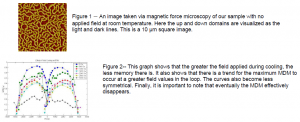Matthew Rytting and Dr. Karine Chesnel, Department of Physics and Astronomy
In my project, we proposed to investigate the effect of field cooling on magnetic domain memory in ferromagnetic films which are exchange coupled with antiferromagnetic material. We analyzed this memory using X-ray speckle correlation, and we performed complementary microscopy measurements so as to get a visualization of the magnetic domains in real space. This helped us understand how magnetization and cooling processes can influence and optimize the magnetic domain memory (MDM). Magnetic domain memory refers to the ability of the domains in the sample to return to the same shape even after the sample has been saturated. See Figure 1 for an example of the domain structure of our sample. High MDM would mean the domains return to this exact shape after an external field is applied and released. High MDM is not common, this apparent maze is generally random, but we have studied ways to induce MDM to the sample.
Our study of this material began with quantifying the degree of MDM when it was cooled without an applied field. Two former students, Brian Wilcken and Joseph Nelson helped develop some of the analysis tools used for my study, and applied them to this zero field cooled case. It was shown that exchange coupling was effective at creating high MDM. My study extends this research into the effect that applying an external magnetic field while cooling has on the samples ability to exhibit MDM.
Data was collected at the ALS at Lawrence Berkeley National Lab. With the funding provided we also took further data at the APS at Argonne National Lab. This data was taken in the form of images captured via X-ray Resonant Magnetic Scattering. These images were processed to obtain just the coherent magnetic scattering and compared to each other to determine the degree of similarity between the different domain morphologies. Because of the coherent nature of the x rays, the images captured a sort of fingerprint of the samples domain shape so that we could determine how the shape changed with a varying magnetic field. The processing of these images was actually more difficult than I had anticipated. The programs we used had several bugs that I had to fix. Further, several of the images had so much noise that it was difficult to smooth them enough to extract the magnetic scattering. This required a lot of optimization of parameters to get data that would be valid.
We analyzed several series of images that were taken after different values of fields were applied during cooling. We found that as the value of the applied field was increased, the amount of MDM actually decreased. This result confirmed that the MDM we found previously is induced by the antiferromagnetic layer being coupled with the ferromagnetic materials. Thus, exchange coupling provides a good method for inducing high memory in the coercive region. This has been shown through both zero field cooling and field cooling measurements. Using antiferromagnetic materials and the induced exchange coupling provides a template for the ferromagnetic layer to exhibit high MDM in the coercive region where the net magnetization of the sample is near zero. The loss of memory during field cooling is likely due to the change undergone by the antiferromagnetic domains during the cooling. This loss of MDM is shown in Fig 2.
These results are significant but preliminary. To further characterize the behavior of MDM, we will fill in missing field cooling values. There is a significant decrease in memory as the cooling field nears the saturation field for the sample, and it would be instructive to have series taken at intermediate values in this region. We plan to do further experiments in which the step size in the applied field is smaller to produce a fuller range of data. We also have already begun to do some experiments at the APS at higher temperatures and will continue to explore the effect of temperature. It would be interesting to explore the effect of film thickness on memory. We have performed some analysis on the effect of Co thickness of the shape of the hysteresis loop with Co/Pt multilayers. It would be interesting to see if there is a similar effect on the hysteresis loop of our sample with a change in Co thickness and to see if this has an effect on MDM. Finally, we would like to expand this research into other types of magnetic material other than cobalt. This area of research offers to greatly improve magnetic data storage as a viable long-term option; we want to add to the fundamental knowledge of these materials so that the best choices can be made.
Some of these results have been approved for publication in the New Journal of Physics under the title of Field mapping and temperature dependence of magnetic domain memory induced by exchange couplings. Further results can be found in my senior thesis with the Physics department. Thank you for your support of this research opportunity.

